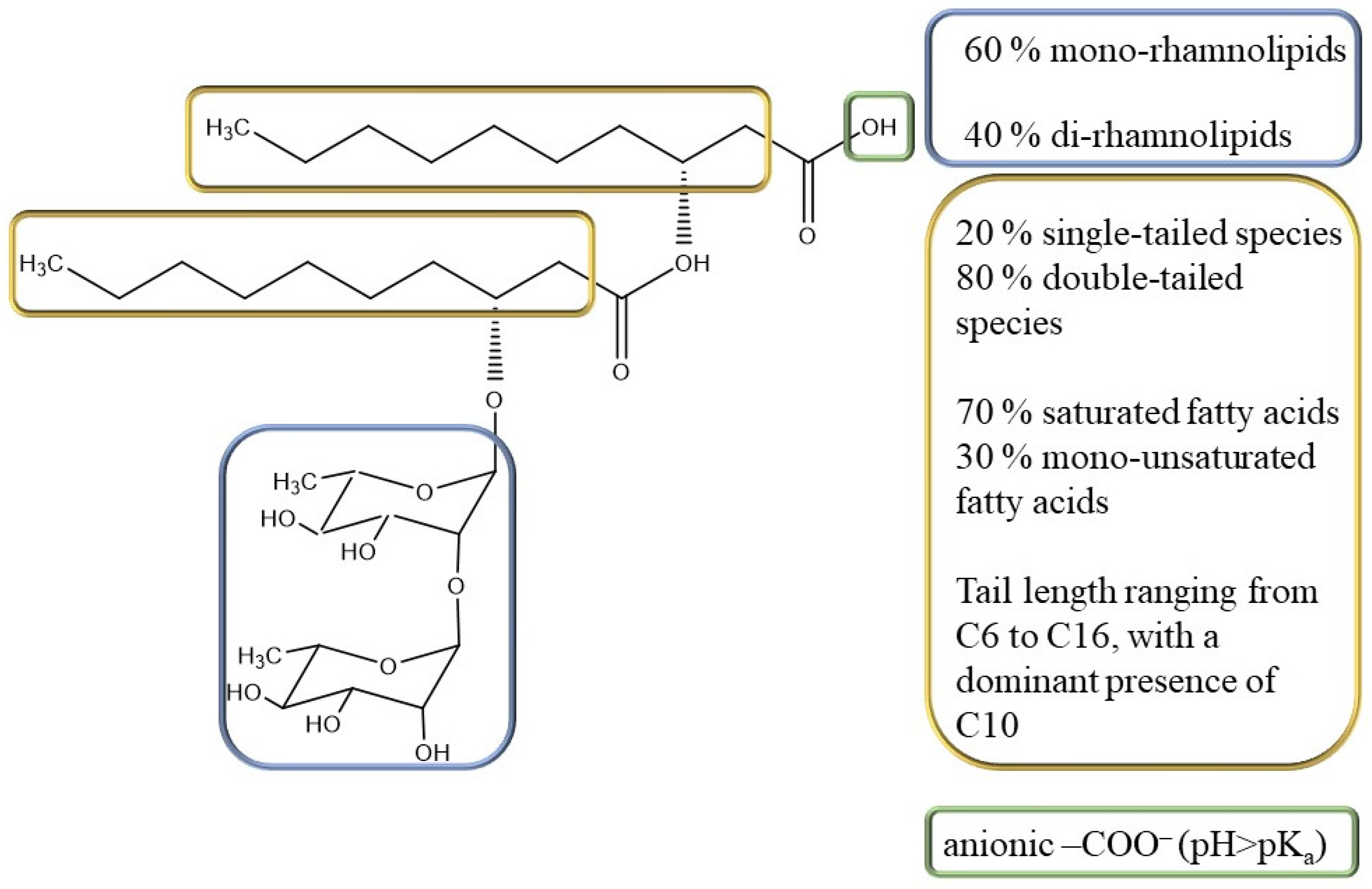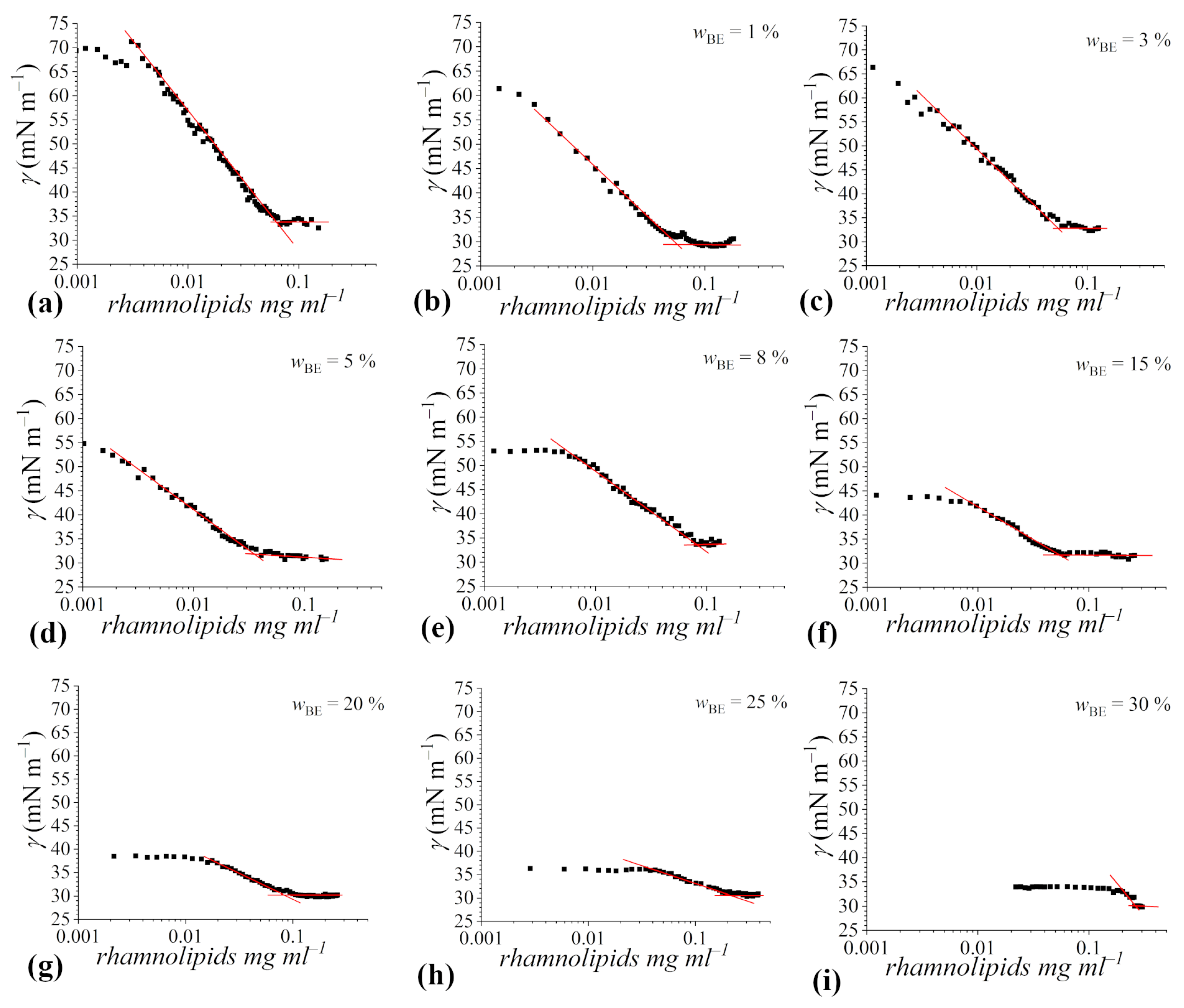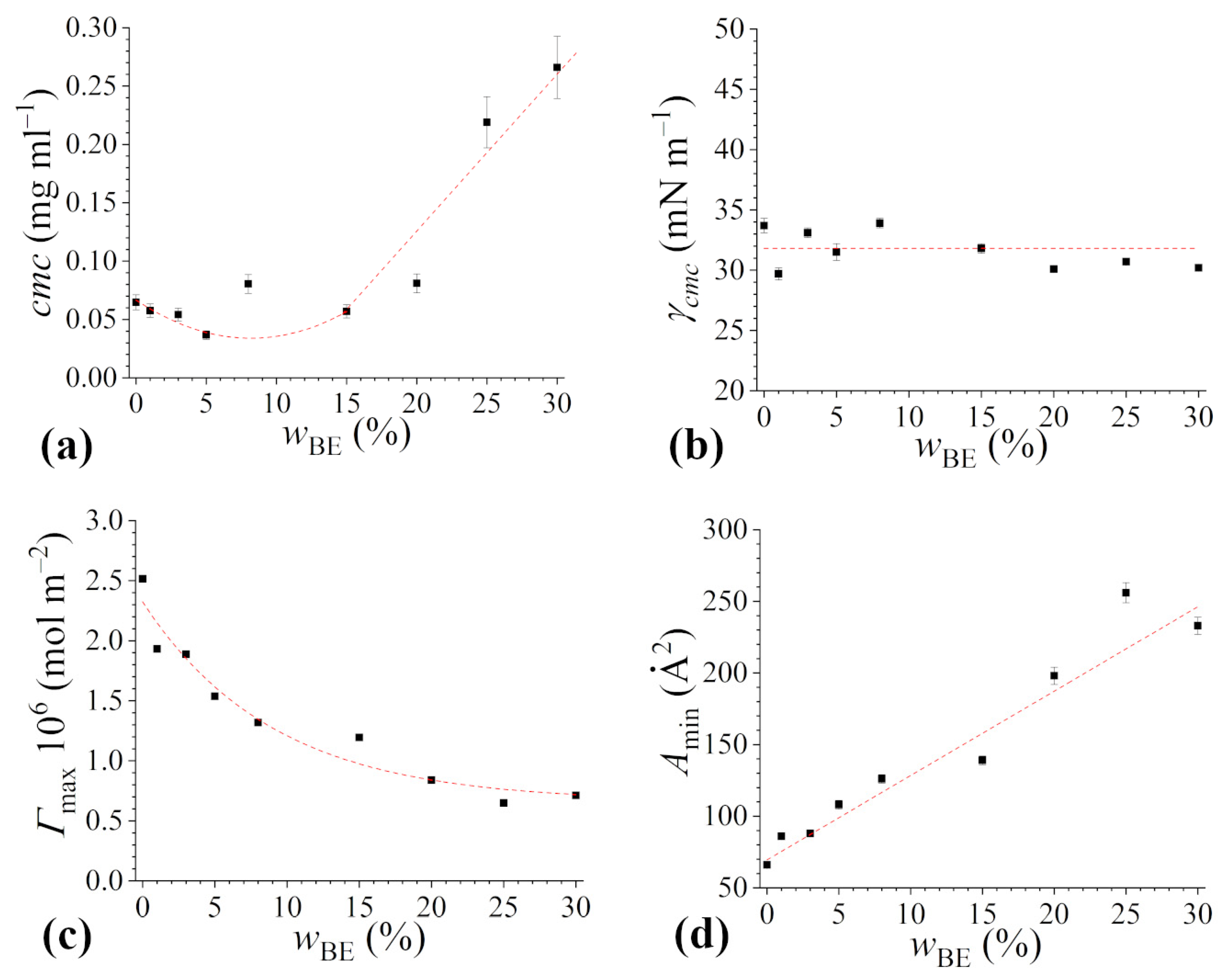Surface and Aggregation Properties of Rhamnolipids in Water–Bioethanol Mixtures: A Step toward Green Formulation Design
Abstract
1. Introduction
2. Materials and Methods
2.1. Materials
2.2. Determination of Refractive Index, Density, and Viscosity of Bioethanol Aqueous Mixtures
2.3. Determination of Surface Tension of Rha-Bioethanol Aqueous Mixtures
2.4. Data Representation and Fitting
3. Results and Discussion
3.1. Physico-Chemical Characterization of Bioethanol Aqueous Mixtures

3.2. Aggregation Behaviour of Rhamnolipids in Water–Bioethanol Mixtures
4. Conclusions
Author Contributions
Funding
Data Availability Statement
Acknowledgments
Conflicts of Interest
References
- Hassim, N.; Markom, M.; Rosli, M.I.; Harun, S. Scale-up approach for supercritical fluid extraction with ethanol–water modified carbon dioxide on Phyllanthus niruri for safe enriched herbal extracts. Sci. Rep. 2021, 11, 15818. [Google Scholar] [CrossRef] [PubMed]
- Shafieian, A.; Khiadani, M.; Nosrati, A. A review of latest developments, progress, and applications of heat pipe solar collectors. Renew. Sust. Energ. Rev. 2018, 95, 273–304. [Google Scholar] [CrossRef]
- Dzigbor, A.; Chimphango, A. Evaluating the potential of using ethanol/water mixture as a refrigerant in adsorption cooling system by using activated carbon-sodium chloride composite adsorbent. Int. J. Refrig. 2019, 97, 132–142. [Google Scholar] [CrossRef]
- Xia, L.; Wang, A.; Zhang, C.; Liu, Y.; Guo, H.; Ding, C.; Wang, Y.; Xu, W. Environmentally friendly dyeing of cotton in an ethanol–water mixture with excellent exhaustion. Green Chem. 2018, 20, 4473–4483. [Google Scholar] [CrossRef]
- Lachenmeier, D.W. Safety evaluation of topical applications of ethanol on the skin and inside the oral cavity. J. Occup. Med. Toxicol. 2008, 3, 26. [Google Scholar] [CrossRef] [PubMed]
- Maier, A.; Ovesen, J.L.; Allen, C.L.; York, R.G.; Gadagbui, B.K.; Kirman, C.R.; Poet, T.; Quiñones-Rivera, A. Safety assessment for ethanol-based topical antiseptic use by health care workers: Evaluation of developmental toxicity potential. Regul. Toxicol. Pharmacol. 2015, 73, 248–264. [Google Scholar] [CrossRef] [PubMed]
- Herdt, B.L.; Ikner, L.A. Inactivation kinetics of benzalkonium chloride and ethanol-based hand sanitizers against a betacoronavirus and an alphacoronavirus. Infect. Prev. Pract. 2023, 5, 100293. [Google Scholar] [CrossRef] [PubMed]
- Kratzel, A.; Todt, D.; V’kovski, P.; Steiner, S.; Gultom, M.; Thao, T.T.N.; Ebert, N.; Holwerda, M.; Steinmann, J.; Niemeyer, D.; et al. Inactivation of severe acute respiratory syndrome coronavirus 2 by WHO-recommended hand rub formulations and alcohols. Emerg. Infect. Dis. 2020, 26, 1592–1595. [Google Scholar] [CrossRef] [PubMed]
- Ribeiro, N.M.; Pinto, A.C.; Quintella, C.M.; da Rocha, G.O.; Teixeira, L.S.G.; Guarieiro, L.L.N.; do Carmo Rangel, M.; Veloso, M.C.C.; Rezende, M.J.C.; Serpa da Cruz, R.; et al. The role of additives for diesel and diesel blended (ethanol or biodiesel) fuels: A review. Energy Fuels 2007, 21, 2433–2445. [Google Scholar] [CrossRef]
- Samanta, S.; Ghosh, P. Coalescence of air bubbles in aqueous solutions of alcohols and nonionic surfactants. Chem. Eng. Sci. 2011, 66, 4824–4837. [Google Scholar] [CrossRef]
- Zdziennick, A.; Jańczuk, B. Modification of adsorption, aggregation and wetting properties of surfactants by short chain alcohols. Adv. Colloid Interface Sci. 2020, 284, 102249. [Google Scholar] [CrossRef] [PubMed]
- Russo Krauss, I.; Cavasso, D.; Ciccarelli, D.; Heenan, R.K.; Ortona, O.; D’Errico, G.; Paduano, L. A Hofmeister series perspective on the mixed micellization of cationic and non-ionic surfactants. J. Mol. Liq. 2021, 335, 116205. [Google Scholar] [CrossRef]
- Russo Krauss, I.; Imperatore, R.; De Santis, A.; Luchini, A.; Paduano, L.; D’Errico, G. Structure and dynamics of cetyltrimethylammonium chloride-sodium dodecylsulfate (CTAC-SDS) catanionic vesicles: High-value nano-vehicles from low-cost surfactants. J. Colloid Interface Sci. 2017, 501, 112–122. [Google Scholar] [CrossRef]
- Farooq, U.; Malik, N.A.; Shalla, A.H. Thermodynamics of cosolvent effect of surface-active ionic liquids on the micellization of conventional surfactant. Colloid Polym. Sci. 2021, 299, 1237–1246. [Google Scholar] [CrossRef]
- Jessop, P.G.; Ahmadpour, F.; Buczynski, M.A.; Burns, T.J.; Green, N.B., II; Korwin, R.; Long, D.; Massad, S.K.; Manley, J.B.; Omidbakhsh, N.; et al. Opportunities for greener alternatives in chemical formulations. Green Chem. 2015, 17, 2664–2678. [Google Scholar] [CrossRef]
- Jayakumar, M.; Gindaba, G.T.; Gebeyehu, K.B.; Selvakumar Periyasamy, S.; Jabesa, A.; Baskar, G.; John, B.I.; Pugazhendhi, A. Bioethanol production from agricultural residues as lignocellulosic biomass feedstock’s waste valorization approach: A comprehensive review. Sci. Total Environ. 2023, 879, 163158. [Google Scholar] [CrossRef] [PubMed]
- Triantafyllos Roukas, Y.; Kotzekidou, P. From food industry wastes to second generation bioethanol: A review. Rev. Environ. Sci. Biotechnol. 2022, 21, 299–329. [Google Scholar] [CrossRef]
- Chandrasekhar, T.; Varaprasad, D.; Gnaneswari, P.; Swapna, B.; Riazunnisa, K.; Anu Prasanna, V.; Korivi, M.; Wee, Y.-J.; Lebaka, V.R. Algae: The reservoir of bioethanol. Fermentation 2023, 9, 712. [Google Scholar] [CrossRef]
- Marchant, R.; Banat, I.M. Biosurfactants: A sustainable replacement for chemical surfactants? Biotechnol. Lett. 2012, 34, 1597–1605. [Google Scholar] [CrossRef]
- Kleinen, J. Will biosurfactants replace conventional surfactants? Curr. Opin. Colloid Interface Sci. 2023, 68, 101764. [Google Scholar] [CrossRef]
- Baccile, N. Are microbial biosurfactants actually only surfactants? Curr. Opin. Colloid Interface Sci. 2023, 68, 101747. [Google Scholar] [CrossRef]
- Esposito, R.; Speciale, I.; De Castro, C.; D’Errico, G.; Russo Krauss, I. Rhamnolipid self-aggregation in aqueous media: A long journey toward the definition of structure–property relationships. Int. J. Mol. Sci. 2023, 24, 5395. [Google Scholar] [CrossRef] [PubMed]
- Widyaningrum, T.; Prastowo, I.; Parahadi, M.; Prasetyo, A.D. Production of bioethanol from the hydrolysate of brown seaweed (Sargassum crassifolium) using a naturally β-glucosidase producing yeast Saccharomyces cereviceae JCM 3012. Biosci. Biotech. Res. Asia 2016, 13, 1333–1340. [Google Scholar] [CrossRef]
- Borines, M.G.; de Leon, R.L.; Cuello, J.L. Bioethanol production from the macroalgae Sargassum spp. Bioresour. Technol. 2013, 138, 22–29. [Google Scholar] [CrossRef]
- Esposito, R.; Ingenito, L.; Cavasso, D.; Siciliano, A.; Alfieri, M.L.; Chiappisi, L.; Fragneto, G.; Ottaviani, M.F.; Guida, M.; Paduano, L.; et al. Rhamnolipid–SLES aqueous mixtures: From the molecular self-aggregation to the functional and ecotoxicological properties. J. Mol. Liq. 2022, 367, 120547. [Google Scholar] [CrossRef]
- Torovic, L.; Srdjenovic-Conic, B.; Kladar, N.; Lukic, D.; Bijelovic, S. Elemental profile of recorded and unrecorded fruit spirits and health risk assessment. J. Food Compos. Anal. 2022, 114, 104807. [Google Scholar] [CrossRef]
- Dodd, L.E. Calibration of Abbe refractometer with compensating prisms, to measure refractive index for any wave length. Rev. Sci. Instrum. 1931, 2, 466–501. [Google Scholar] [CrossRef]
- Prokopová, O.; Blahut, A.; Čenský, M.; Součková, M.; Vinš, V. Comments on temperature calibration and uncertainty estimate of the vibrating tube densimeter operated at atmospheric pressure. J. Chem. Thermodyn. 2022, 173, 106855. [Google Scholar] [CrossRef]
- Sariyerli, G.S.; Sakarya, O.; Yuksel Akcadag, U. Comparison tests for the determination of the viscosity values of reference liquids by capillary viscometers and stabinger viscometer SVM 3001. Int. J. Metrol. Qual. Eng. 2018, 9, 7. [Google Scholar] [CrossRef]
- Harkins, W.D.; Young, T.F.; Cheng, L.H. The ring method for the determination of surface tension. Science 1926, 64, 333–336. [Google Scholar] [CrossRef]
- D’Errico, G.; Ciccarelli, D.; Ortona, O. Effect of glycerol on micelle formation by ionic and nonionic surfactants at 25 °C. J. Colloid Interface Sci. 2005, 286, 747–754. [Google Scholar] [CrossRef] [PubMed]
- Antony, A.; Mitra, J. Refractive index-assisted UV/Vis spectrophotometry to overcome spectral interference by impurities. Anal. Chim. Acta 2021, 1149, 238186. [Google Scholar] [CrossRef] [PubMed]
- Synovec, R.E.; Yeung, E.S. Quantitative analysis without analyte identification by refractive index detection. Anal. Chem. 1983, 55, 1599–1603. [Google Scholar] [CrossRef]
- Khattab, I.S.; Bandarkar, F.; Fakhree, M.A.A.; Jouyban, A. Density, viscosity, and surface tension of water+ethanol mixtures from 293 to 323 K. Korean J. Chem. Eng. 2012, 29, 812–817. [Google Scholar] [CrossRef]
- Herráez, J.V.; Belda, R. Refractive indices, densities and excess molar volumes of monoalcohols + water. J. Solut. Chem. 2006, 35, 1315–1328. [Google Scholar] [CrossRef]
- Pečar, D.; Doleček, V. Volumetric properties of ethanol–water mixtures under high temperatures and pressures. Fluid Phase Equilibria 2005, 230, 36–44. [Google Scholar] [CrossRef]
- Hoga, H.E.; Torres, R.B.; Volpe, P.L.O. Thermodynamics properties of binary mixtures of aqueous solutions of glycols at several temperatures and atmospheric pressure. J. Chem. Thermodyn. 2018, 122, 38–64. [Google Scholar] [CrossRef]
- Zarei, H.A.; Jalili, F.; Assadi, S. Temperature dependence of the volumetric properties of binary and ternary mixtures of water (1) + methanol (2) + ethanol (3) at ambient pressure (81.5 kPa). J. Chem. Eng. Data 2007, 52, 2517–2526. [Google Scholar] [CrossRef]
- Cheng, N.-S. Formula for the viscosity of a glycerol-water mixture. Ind. Eng. Chem. Res. 2008, 47, 3285–3288. [Google Scholar] [CrossRef]
- González, B.; Calvar, N.; Gómez, E.; Domínguez, Á. Density, dynamic viscosity, and derived properties of binary mixtures of methanol or ethanol with water, ethyl acetate, and methyl acetate at T=(293.15, 298.15, and 303.15)K. J. Chem. Thermodyn. 2007, 39, 1578–1588. [Google Scholar] [CrossRef]
- Jia, X.-Q.; Li, Y.; Zhang, C.-X.; Gao, Y.-C.; Wu, Y. Supramolecular clusters clarification in ethanol-water mixture by using fluorescence spectroscopy and 2D correlation analysis. J. Mol. Struct. 2020, 1219, 128569. [Google Scholar] [CrossRef]
- Choi, S.; Parameswaran, S.; Choi, J.-H. Understanding alcohol aggregates and the water hydrogen bond network towards miscibility in alcohol solutions: Graph theoretical analysis. Phys. Chem. Chem. Phys. 2020, 22, 17181–17195. [Google Scholar] [CrossRef] [PubMed]
- Deng, G.-H.; Shen, Y.; Chen, H.; Chen, Y.; Jiang, B.; Wu, G.; Yang, X.; Yuan, K.; Zheng, J. Ordered-to-disordered transformation of enhanced water structure on hydrophobic surfaces in concentrated alcohol−water solutions. J. Phys. Chem. Lett. 2019, 10, 7922–7928. [Google Scholar] [CrossRef] [PubMed]
- Kuchuk, V.I.; Shirokova, I.Y.; Golikova, E.V. Physicochemical properties of water–alcohol mixtures of a homological series of lower aliphatic alcohols. Glass Phys. Chem. 2012, 38, 460–465. [Google Scholar] [CrossRef]
- Vazquez, G.; Alvarez, E.; Navaza, J.M. Surface tension of alcohol + water from 20 to 50 °C. J. Chem. Eng. Data 1995, 40, 611–614. [Google Scholar] [CrossRef]
- Rekiel, E.; Zdziennicka, A.; Jańczuk, B. Adsorption properties of rhamnolipid and ethanol at water/ethanol solution-air interface. J. Mol. Liq. 2022, 308, 113080. [Google Scholar] [CrossRef]
- Shinoda, K.; Hutchinson, E. Pseudo-phase separation model for thermodynamic calculations on micellar solutions. J. Phys. Chem. 1962, 66, 577–582. [Google Scholar] [CrossRef]
- Ambrosone, L.; Costantino, L.; D’Errico, G.; Vitagliano, V. Thermodynamic and dynamic properties of micellar aggregates of nonionic surfactants with short hydrophobic tails. J. Colloid Interface Sci. 1997, 190, 286–293. [Google Scholar] [CrossRef] [PubMed]
- Esposito, R.; Gallucci, N.; Niccoli, M.; Cavalcanti, L.P.; Russo Krauss, I.; Paduano, L.; D’Errico, G. Synergism and molecular mismatch in rhamnolipid/CTAC catanionic surfactant mixtures. Colloids Surf. A 2023, 674, 131931. [Google Scholar] [CrossRef]
- Üner, O.; Akkurt, N. Micellization and thermodynamics study of N-alkyl-4-methylpyridinium bromides in water and mixed water–ethanol media. J. Mol. Liq. 2022, 352, 118765. [Google Scholar] [CrossRef]
- Shilova, S.V.; Tret’yakova, A.Y.; Barabanov, V.P. Association of quaternized poly(4-vinylpyridine) and sodium dodecyl sulfate in water-alcohol solvents. Polym. Sci. Ser. A 2010, 52, 1283–1291. [Google Scholar] [CrossRef]
- Moreira, L.A.; Firoozabadi, A. Thermodynamic modeling of the duality of linear 1-alcohols as cosurfactants and cosolvents in self-assembly of surfactant molecules. Langmuir 2009, 25, 12101–12113. [Google Scholar] [CrossRef] [PubMed]
- Zana, R. Aqueous surfactant-alcohol systems: A review. Adv. Colloid Interface Sci. 1995, 57, 1–64. [Google Scholar] [CrossRef]
- Zana, R.; Yiv, S.; Strazielle, C.; Lianos, P. Effect of alcohol on the properties of micellar systems: I. Critical micellization concentration, micelle molecular weight and ionization degree, and solubility of alcohols in micellar solutions. J. Colloid Interface Sci. 1981, 80, 208–223. [Google Scholar] [CrossRef]
- Førland, G.M.; Samseth, J.; Gjerde, M.I.; Høiland, H.; Jensen, A.Ø.; Mortensen, K. Influence of alcohol on the behavior of sodium dodecylsulfate micelles. J. Colloid Interface Sci. 1998, 203, 328–334. [Google Scholar] [CrossRef] [PubMed]
- Sidim, T.; Acar, G. Alcohols effect on critic micelle concentration of polysorbate 20 and cetyl trimethyl ammonium bromine mixed solutions. J. Surfactants Deterg. 2013, 16, 601–607. [Google Scholar] [CrossRef] [PubMed]
- Akhter, M.S. Effect of solubilization of alcohols on critical micelle concentration of non-aqueous micellar solutions. Colloids Surf. A 1999, 157, 203–210. [Google Scholar] [CrossRef]
- Niraula, T.P.; Shah, R.; Kumar, D.; Dominguez, H.; Ríos-López, M.; Salazar-Arriaga, A.B.; De, R.; Bhattarai, A. Influence of solvent permittivity and divalent salt on micellization behavior of sodium dodecyl sulfate: Conductivity measurements and simulation study. J. Mol. Liq. 2022, 349, 118186. [Google Scholar] [CrossRef]
- Soni, S.S.; Panjabi, S.H.; Sastry, N.V. Effect of non-electrolyte additives on micellization and clouding behavior of silicone surfactant in aqueous solutions. Colloids Surf. A 2011, 377, 205–211. [Google Scholar] [CrossRef]
- Castronuovo, G.; Elia, V.; Moniello, V.; Velleca, F.; Perez-Casas, S. Effect of a cosolvent on the hydrophobic interactions. A calorimetric study of alkane-m,n-diols in concentrated aqueous solutions of ethanol. Phys. Chem. Chem. Phys. 1999, 1, 1887–1892. [Google Scholar] [CrossRef]
- Zdziennicka, A.; Jańczuk, B. Behavior of anionic surfactants and short chain alcohols mixtures in the monolayer at the water–air interface. J. Surfactants Deterg. 2011, 14, 257–267. [Google Scholar] [CrossRef]
- Rekiel, E.; Zdziennicka, A.; Jańczuk, B. Adsorption of surfactin at water with ethanol mixture-air interface. J. Mol. Liq. 2020, 300, 112240. [Google Scholar] [CrossRef]
- Zdziennicka, A. Surface behavior of Triton X-165 and short chain alcohol mixtures. Langmuir 2010, 26, 1860–1869. [Google Scholar] [CrossRef] [PubMed]
- Sheng, R.; Ding, Q.Y.; Ren, Z.H.; Li, D.N.; Fan, S.C.; Cai, L.L.; Quan, X.F.; Wang, Y.; Yi, M.T.; Zhang, Y.X.; et al. Interfacial and Micellization Behavior of Binary Mixture of Amino Sulfonate Amphoteric Surfactant and Octadecyltrimethyl Ammonium Bromide: Effect of Short Chain Alcohol and Its Chain Length. J. Mol. Liq. 2021, 334, 116064. [Google Scholar] [CrossRef]
- Rosen, M.J.; Kunjappu, J.T. Surfactants and Interfacial Phenomena; John Wiley & Sons: Hoboken, NJ, USA, 2012; pp. 235–271. [Google Scholar]
- Costantino, L.; D’Errico, G.; Roscigno, P.; Vitagliano, V. Effect of urea and alkylureas on micelle formation by a nonionic surfactant with short hydrophobic tail at 25 °C. J. Phys. Chem. B 2000, 104, 7326–7333. [Google Scholar] [CrossRef]
- Russo Krauss, I.; Esposito, R.; Paduano, L.; D’Errico, G. From composite molecular structures to a multiplicity of supramolecular aggregates: The role of intermolecular interactions in biosurfactant self-assembly. Curr. Opin. Colloid Interface Sci. 2024, 70, 101792. [Google Scholar] [CrossRef]



Disclaimer/Publisher’s Note: The statements, opinions and data contained in all publications are solely those of the individual author(s) and contributor(s) and not of MDPI and/or the editor(s). MDPI and/or the editor(s) disclaim responsibility for any injury to people or property resulting from any ideas, methods, instructions or products referred to in the content. |
© 2024 by the authors. Licensee MDPI, Basel, Switzerland. This article is an open access article distributed under the terms and conditions of the Creative Commons Attribution (CC BY) license (https://creativecommons.org/licenses/by/4.0/).
Share and Cite
Esposito, R.; Taddeo, F.; Russo, V.; Russo Krauss, I.; D’Errico, G. Surface and Aggregation Properties of Rhamnolipids in Water–Bioethanol Mixtures: A Step toward Green Formulation Design. Surfaces 2024, 7, 251-264. https://doi.org/10.3390/surfaces7020017
Esposito R, Taddeo F, Russo V, Russo Krauss I, D’Errico G. Surface and Aggregation Properties of Rhamnolipids in Water–Bioethanol Mixtures: A Step toward Green Formulation Design. Surfaces. 2024; 7(2):251-264. https://doi.org/10.3390/surfaces7020017
Chicago/Turabian StyleEsposito, Rodolfo, Francesco Taddeo, Vincenzo Russo, Irene Russo Krauss, and Gerardino D’Errico. 2024. "Surface and Aggregation Properties of Rhamnolipids in Water–Bioethanol Mixtures: A Step toward Green Formulation Design" Surfaces 7, no. 2: 251-264. https://doi.org/10.3390/surfaces7020017
APA StyleEsposito, R., Taddeo, F., Russo, V., Russo Krauss, I., & D’Errico, G. (2024). Surface and Aggregation Properties of Rhamnolipids in Water–Bioethanol Mixtures: A Step toward Green Formulation Design. Surfaces, 7(2), 251-264. https://doi.org/10.3390/surfaces7020017









